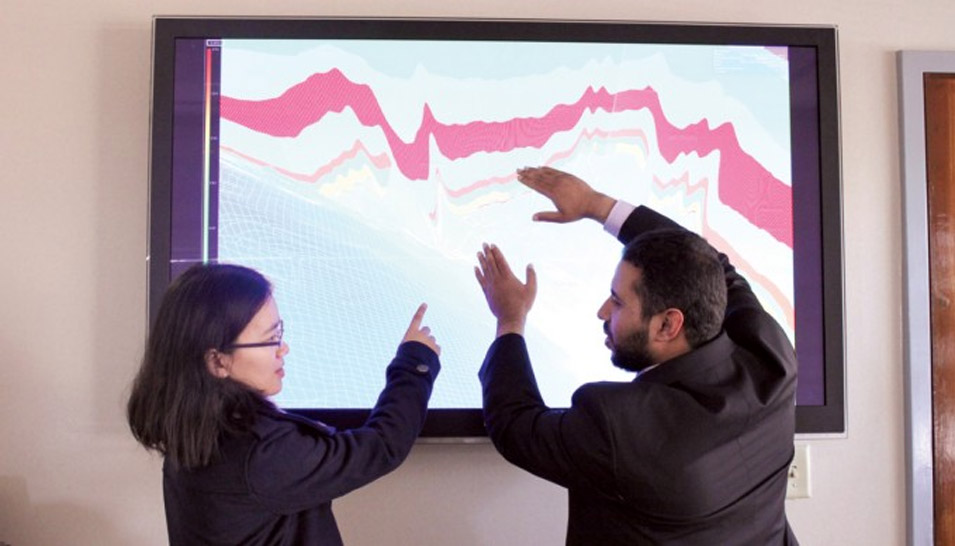
Shouhong Du and Ahmad Youbi, petroleum engineering system analysts with Saudi Aramco, examine the geological rock properties of a basin model during a high-resolution test run of the basin simulator.
Saudi Aramco’s first in-house basin simulator was recently introduced to our upstream scientists, showcasing the capabilities of the powerful new simulator, which is designed to reveal the hidden journey of oil to its present day locations to support explorationists in their discovery of new hydrocarbon deposits.
Our TeraPOWERS Technology Team (TPT), part of the EXPEC Advanced Research Center, presented the basin simulator to the user community during a pair of workshops held at the Upstream Professional Development Center. The simulator was launched to simulate the geologic evolution of the Arabian sedimentary basin at an unprecedented level of detail, revealing the hidden journey of oil.
The technology is unique because it can handle extremely large models that are required to simulate the petroleum systems of the Arabian Peninsula. It also allows the integration of geological information from reservoirs at an unprecedented resolution.
Communication and Collaboration

Ali Dogru explains the fundamental processes
of the basin simulator to workshop participants.
Among the simulator’s capabilities include the
structural evolution of a basin and the expulsion
and migration of hydrocarbons.
Ali Dogru, chief technologist of TeraPOWERS Technology Division, opened the workshop with an overview of the technological development of the basin simulator.
Dogru explained the fundamental processes of the basin simulator, ranging from the structural evolution of a basin to the expulsion and migration of hydrocarbons, to familiarize the participants with the new technology. He also laid out plans for the future development of the basin simulator, and ended his presentation by explaining the concepts for the cooperation of TPT with the users of the Saudi Aramco basin simulator.
“Communication and collaboration with our proponents is preeminent in our research undertakings,” said Dogru. “As a cornerstone technology of Saudi Aramco, GigaPOWERS, TeraPOWERS, and now this release of the first Saudi Aramco basin simulator, require continued close interaction between our customers and the TeraPOWERS team to ensure user satisfaction and that this powerful technology continues to be developed to deliver optimal performance throughout its future.”
Ali Dogru
"Communication and collaboration with our proponents is preeminent in our research undertakings. This powerful technology continues to be developed to deliver optimal performance throughout its future."
Pushing the Boundaries of Technology
Ali A. Al-Meshari, EXPEC ARC manager, highlighted the strategic importance of the basin simulator for Saudi Aramco.
“The team’s efforts to push the boundaries of technology in our industry have been necessary to deliver the innovations capable of simulating the gigantic fields of Saudi Arabia in their entirety,” said Al-Meshari. “But they didn’t stop there. Today, the TeraPOWERS team introduces the technology that will simulate the entire basin, providing Saudi Aramco an even more powerful engine to explore for hydrocarbons with even greater accuracy and more efficiency.”
Through a number of hands-on exercises, workshop participants learned the functions of a software product that plays a key role for the future exploration strategy of Saudi Aramco. After a discussion of the input data, workshop participants used a number of software tools to define their basin models. Geologic, geochemical, and geophysical information was used in a simulation to determine when and where oil and gas were formed over geological history spanning an age range of more than 500 million years.
Assessing Risk, Estimating Reserves

Javed Ismael from the Eastern Area Exploration
Department joins Tom Byer, Guido Port, and
Florian Mannuss of the EXPEC Advanced
Research Center during the recent in-house
basin simulator workshop held in Dhahran.
Among the numerous capabilities of the basin simulator, the calculation of prospect “charge risk” and estimation of oil reserves of the Kingdom will significantly benefit from the application of this in-house software.
A prospect is a place identified by Area Exploration to drill for oil. Before drilling, geologists cannot be 100% sure that they will find oil in that place. If they don’t find oil, the reason may be that oil has never moved (“migrated”) into the prospect. The likelihood of oil moving into a prospect is “charge risk.”
“I have been using multiple tools throughout my career to help achieve risk mitigation in charge related issues,” said Javed Ismail, a geological consultant who has worked for more than 20 years with Eastern Area Exploration.
“The roll-out of this initial version of the TeraPOWERS basin simulator is a valuable advancement. The technology will contribute to strengthening our capabilities in the ongoing charge systems analysis work within Saudi Aramco to reduce exploration risk and increase discovery of new hydrocarbon resources.”
The Present and the Future
The workshops concluded with an open discussion regarding the basin simulator roadmap. Basin workshop attendees provided their feedback to the TPT team, which will use the customer input to update the 2017 working plans based on the project roadmap.
A mid-year release of the basin simulator includes a Hybrid Darcy migration, which will generate migration pathways for hydrocarbons over millions of years more accurately, allowing explorationists to drill for potential trapped hydrocarbons along the migration pathways for additional reserves.
The next phases will include additional graphical software such as Petrel workflows and Lithology and Kinetic Editors, which provide user graphical tools to prepare and input data available in the company database easily, and graphically input and edit erosion and kinetic data, thereby saving man-hours.